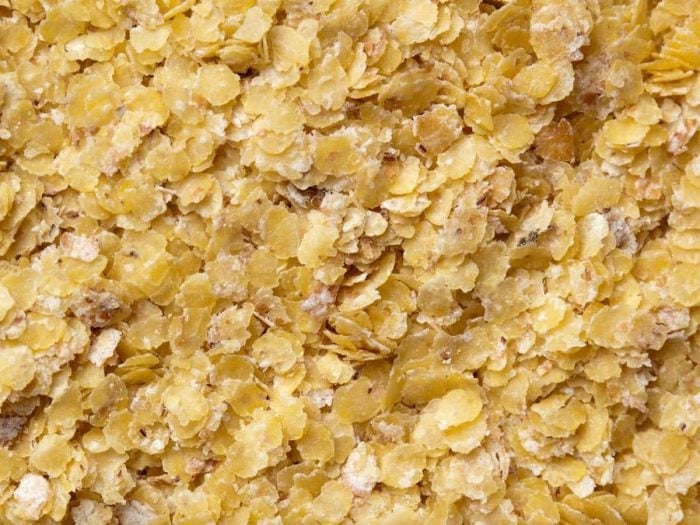A wheat germ is a part of the wheat kernel that may help in reproducing the plant. Naturally, it contains the nutrients needed to grow and develop into a healthy, new organism. Wheat germ is the small, nutrient-containing center of a wheat kernel, comprising only about 2.5 percent of the weight of the kernel, but packing possibly a very beneficial list of attributes.
The health benefits of wheat germ may include a boost to the immune system and a preventative measure against cardiovascular diseases. It may also have anti-aging properties, and can positively affect mental agility, muscle development, stamina, and wound healing. The nutrients in wheat germs might even aid in digestion, prevent damage to the arteries, and help in weight loss.
Certain food can be nutritious ‘overall’ implying that every part is healthy for consumption. Wheat is one of those, and wheat germ is the healthy part that contains the majority of the nutrients. A wheat kernel consists of the outside shell (wheat bran), the starchy endosperm (used to mill flour), and the wheat germ (the reproductive element).
What is Wheat Germ?
For years, wheat kernels were used mainly to mill flour, in which case the bran and germ parts were casually thrown away and white flour was produced, which held little or no nutritional value. In fact, once synthetic vitamins and bleaches are added to the flour, it actually does more harm than good.
When it is extracted from the kernel and isolated into natural oils, or when the grain is eaten entirely, the nutritional benefits of the germ can be passed into our body. It is often turned into cooking or baking oil for highly concentrated doses of wheat germ on salads or in pasta sauces, but it should not be used as a frying oil because most of the nutrients are lost when heated to that level.
It can act as an additive in desserts or smoothies or even as a replacement for breadcrumbs or flour in many recipes, conferring a wealth of nutritional benefits on those who add it to their diet.
In the current climate, where people are more careful about their health, nearly every store will sell raw wheat germ in or around the cereal aisle, so get creative, and get cooking!

Toasted wheat germ flakes are a good source of protein. Photo Credit: Shutterstock
| Serving Size : | |
|---|---|
| Nutrient | Value |
| Water [g] | 11.12 |
| Energy | 360 |
| Energy [kJ] | 1506 |
| Protein [g] | 23.15 |
| Total lipid (fat) [g] | 9.72 |
| Ash [g] | 4.21 |
| Carbohydrate, by difference [g] | 51.8 |
| Fiber, total dietary [g] | 13.2 |
| Calcium, Ca [mg] | 39 |
| Iron, Fe [mg] | 6.26 |
| Magnesium, Mg [mg] | 239 |
| Phosphorus, P [mg] | 842 |
| Potassium, K [mg] | 892 |
| Sodium, Na [mg] | 12 |
| Zinc, Zn [mg] | 12.29 |
| Copper, Cu [mg] | 0.8 |
| Manganese, Mn [mg] | 13.3 |
| Selenium, Se [µg] | 79.2 |
| Thiamin [mg] | 1.88 |
| Riboflavin [mg] | 0.5 |
| Niacin [mg] | 6.81 |
| Pantothenic acid [mg] | 2.26 |
| Vitamin B-6 [mg] | 1.3 |
| Folate, total [µg] | 281 |
| Folate, food [µg] | 281 |
| Folate, DFE [µg] | 281 |
| Fatty acids, total saturated [g] | 1.67 |
| 14:0 [g] | 0.01 |
| 16:0 [g] | 1.59 |
| 18:0 [g] | 0.06 |
| Fatty acids, total monounsaturated [g] | 1.37 |
| 16:1 [g] | 0.03 |
| 18:1 [g] | 1.33 |
| Fatty acids, total polyunsaturated [g] | 6.01 |
| 18:2 [g] | 5.29 |
| 18:3 [g] | 0.72 |
| Tryptophan [g] | 0.32 |
| Threonine [g] | 0.97 |
| Isoleucine [g] | 0.85 |
| Leucine [g] | 1.57 |
| Lysine [g] | 1.47 |
| Methionine [g] | 0.46 |
| Cystine [g] | 0.46 |
| Phenylalanine [g] | 0.93 |
| Tyrosine [g] | 0.7 |
| Valine [g] | 1.2 |
| Arginine [g] | 1.87 |
| Histidine [g] | 0.64 |
| Alanine [g] | 1.48 |
| Aspartic acid [g] | 2.07 |
| Glutamic acid [g] | 4 |
| Glycine [g] | 1.42 |
| Proline [g] | 1.23 |
| Serine [g] | 1.1 |
| Sources include : USDA [1] | |
Wheat Germ Nutrition Facts
Although the wheat germ is small, the nutrients it contains are impressive and formidable. The outer shell of the wheat kernel, the bran, is beneficial as well, but the germ has more necessary nutrients that make it desirable.
Wheat germ may prove to be a bountiful source of energy, fiber, protein, and complex carbohydrates, all of which interact in numerous ways with the body’s internal systems. Important daily vitamins like folate, vitamin E, and vitamin B (Niacin, Thiamin, and B6) may also be found in high levels in it. In terms of minerals, wheat germ provides high levels of potassium and iron, as well as very good levels of zinc, calcium, potassium, phosphorus, and selenium. [2]
It also has omega-3 fatty acids, one of the necessary and beneficial forms of cholesterol found in the body that needs frequent replenishing from dietary sources like wheat germ.
Health Benefits of Wheat Germ
Wheat germ provides a great range of nutritional benefits that can help you maintain a healthy lifestyle. Let’s take a detailed look at them.
May Boost Immune System
By adding wheat germs to your diet, you may positively boost your immune system to fight against several diseases. Experimental results using wheat germ protein hydrolysates suggest that it may positively increase the antioxidant activity in organic systems. Antioxidants seek out and destroy free radicals and other disease-causing microorganisms in the body, reducing or eliminating the chances of serious illness. Wheat germ has been shown to naturally contain high levels of these hydrolysates that may help stimulate the antioxidants within the immune system. [3]
May Improve Heart Health
Studies have shown that the regular intake of whole-grain wheat and wheat germ can reduce risk factors associated with coronary heart health and can increase the health of the entire cardiovascular system. LDL cholesterol is the cholesterol that has been oxidized and therefore, swells in the arteries and veins. Including wheat germ in your diet increases the amount of dietary fiber, which has also been scientifically linked to a good heart health. The presence of octacosanol in wheat germ has also been shown to reduce cholesterol levels. High levels of omega-3 fatty acids in wheat germs may work to cancel out the negative effects of omega-6 fatty acids, further protecting your cardiovascular system. [4] [5]
May Have Anti-aging Properties
Wheat germ may be packed with nutrients and vitamins and can have a significant impact on various anti-aging effects like skin quality and hair loss. Wheat germ might potentially be a natural way to get these benefits, but some people also choose to go for a more cosmetic approach, using its extract directly or mixing it with other cosmetic materials. Vitamin E may be packed into it as well, and studies have shown a wide range of benefits to people who fill their daily requirements of this vitamin. When eaten regularly, the proteins and vitamins within wheat germ may positively affect people with conditions like psoriasis, sunburn, eczema, wrinkles, dull complexion, and receding hairlines. [6] [7]
May Help Increase Athletic Performance
Studies have shown wheat germ to have high levels of naturally occurring octacosanol, which has certain ergogenic qualities. This means that when taken as a part of a regular diet, it may increase stamina and performance by regulating the biochemical pathways that produce energy, which in effect might help streamline the saving of energy reserves in the body. It should be noted that while these effects have been scientifically proven multiple times, as many variables come into play, the scientific backing for the wheat germ as a performance-enhancing dietary choice is moderate to weak. [8]
May Improve Cellular Metabolism
Other beneficial vitamins that may be found in wheat germ are B-vitamins, which consist of several different vitamins. The most common types found in wheat germ are niacin, thiamine, and folates. These vitamins are vital for cellular metabolism, that may help transform nutrients from carbohydrates, lipids, and glucose into consumable energy for the cells. Thiamine can also fight against metabolic disorders such as chronic obesity. A higher functioning metabolism means more natural energy, as well as more successful weight loss, strength, and alertness. B vitamins can be found in many whole grains as well as in wheat germ. [9] [10]
May Boost Muscle Health
Protein may have a long list of beneficial attributes, and luckily, one of the best sources of protein in a diet can come from wheat germ. Protein may play an integral role in maintaining healthy muscles, repairing damaged tissues, regulating energy levels within the body, and aiding in homeostasis and overall system balance. Protein may also be an essential dietary requirement for people wanting to get in shape and increase their muscle mass. [11]
May Support Healthy Pregnancy
Wheat germ may be loaded with folic acid, which is an important factor in ensuring a healthy infant for pregnant women. Women who have healthy levels of folates in their system have a greatly reduced chance of their child having neural tube defects and other complications. Adding it to your diet when pregnant can be beneficial in many ways, given its nutrient-packed nature, but the high levels of folic acid make it particularly attractive and popular. [12]
May Reduce Diabetes Risk
The presence of high folic acid in wheat germ may have a secondary effect on people at risk of diabetes. Folic acid is negatively correlated with a compound called ‘homocysteine’ in the body, which is closely linked to some harmful conditions, like vascular disease, diabetes. Folic acid may be present in many whole grains and is particularly high levels in wheat germ. Therefore, if you add normal, healthy doses of wheat germ to your diet, you will likely reduce the levels of homocysteine in your body, and may reduce your chances of developing these medical conditions. [13]
Side Effects of Wheat Germ
Not Gluten-friendly: A growing number of the population can no longer eat gluten, which is a primary component in grains such as wheat. This gluten intolerance can often be caused by other diseases. Eating gluten can be painful and harmful to the digestive tract, and even fatal in some extreme conditions. Despite the other nutritional benefits of wheat germ, if you are required to maintain a “gluten-free” diet, do not consume wheat germ or wheat germ extract. [14]
High in Calories: Besides being nutrient-rich, wheat germ is very high in calories. The positive benefits of this germ can be canceled out if the intake of other daily calories is not monitored because weight gain and subsequent health issues can occur.
